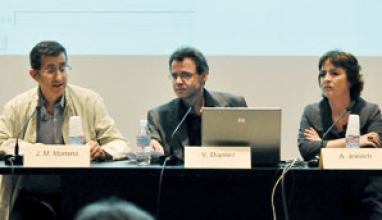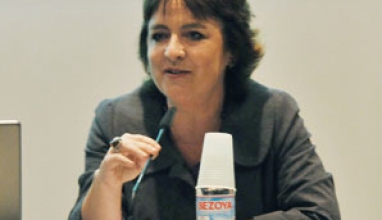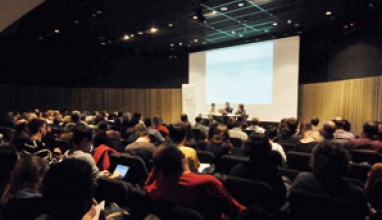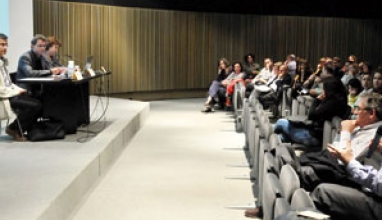You are here
Segregation in schools: social and political challenges
About the speaker
Vincent Dupriez
Sociologist and Head of Studies at Paris's École des Hautes Études en Sciences Sociales (EHESS)
What is considered segregation?
Segregation is the unequal distribution of individuals depending on their specific traits. In the area of schools, this may occur due to academic questions (depending on the level of students), and social or ethnic questions.
When did segregation begin to be studied?
Concern over segregation in schools is recent. Before the Second World War, it was obvious that school segregation existed in Europe: there were high-quality schools for the middle and upper classes and schools for the working class. There was no permeability between the two systems. Concern for bringing democracy to the educational system began to arise following the Second World War: education must guarantee equality of opportunity and it must be plural. The idea of the single comprehensive school came into being.
What kinds of studies are being done on this subject?
• There is greater concern about the effects of segregation than about segregation in and of itself. For Dupriez, it would be interesting to study the importance of mixing in schools. Dupriez considers that “school is the place where one learns to live with different groups and individuals”, therefore, it is important for schools to be heterogeneous.
• It is also important to include new variables. For example, the lack of mixing affects schoolchildren’s aspirations.
• International studies, such as the PISA report, have studied the subject of segregation, mixing it with other variables such as levels of social inequality or educational levels of parents. Results from these studies affirm that educational level of parents is directly proportional to the level of school results of their children. Another verification is that in countries with a high degree of school segregation social inequality has also been observed in schools. Yet another variable is that the level of segregation negatively affects level of effectiveness.
• In countries where segregation exists, national studies have been done on this aspect. These studies have arrived at the conclusion that the composition of a school affects the end level of knowledge both directly and indirectly. Directly, for instance, because students in a school where the overall level is low have little desire to study and achieve good results. Indirectly, in that in a school where the level is low, teachers, consciously or unconsciously, end up adapting the curriculum to students’ levels and this, according to Dupriez, affects the final outcome of their schooling.
What does segregation depend on?
• On residential segregation.
Above all, if we add to this factor the fact that the system of schooling establishes that students attend schools close to their homes.
• On rules of schooling.
It has been shown that if families can choose the school they will send their child to, segregation will occur. This relation is not as determining as the preceding one, but it accentuates segregation if residential segregation already exists.
• On systems of educational itineraries.
Countries in which educational itineraries are applied at an earlier age show a higher degree of segregation. In the Nordic countries, which opt for common itineraries until the age of 16, segregation is less frequent.
• On the autonomy of schools for selecting students.
• On the autonomy of schools for creating their own curriculums.
According to Dupriez, over the past 10 or 15 years the role of the State has come into question in relation to educational regulation. The centralism and inefficiency of this type of administrative action has been highly criticized. In contrast, a new model has appeared: the State is not the doer but the appraiser. The state defines objectives, provides resources and appraises the results. Schools have autonomy for administering them. For Dupriez, it has not been empirically demonstrated that the autonomy of schools signifies an overall improvement of scholastic level. Dupriez considers that excess of autonomy may mean that each school establishes different curricular levels. In cases where, in addition, these are schools where segregation occurs, autonomy is transformed into a lowering of academic level to adapt to types of students.
Conclusions. Factors for struggling against segregation
• Intervention in other social areas that also affect segregation, such as housing, health and work. Segregation is not the only cause of poor scholastic results. Family support must also be encouraged, as well as policies of positive discrimination in schools, which although they do not go against segregation may help reduce social inequalities.
• Regulation of the enrollment model.
Criteria that promote mixing should be a top priority. According to Dupriez, however, the regulation that is established must count on the legitimacy of the professional collective and of parents. Dupriez refers to the example of Belgium, which attempted to implement an initiative whereby, in the case of a tie in points, a drawing was to determine the school that children would attend. The initiative failed because society was not of the opinion that choosing a school be done in a random way.
• Regulation of the curriculum and external evaluation.
A national curriculum is needed that establishes homogeneous levels for all schools. Schools may exercise autonomy in implementing this curriculum, as long as these different methods achieve the same level. Dupriez is against adapting the curriculum to the type of student when this signifies lowering the academic level. Furthermore, the autonomy of schools must be accompanied by control of results with external evaluations. The evaluation must serve to improve, not to penalize. Dupriez criticizes the British model in which the obsession for measuring has become a problem, because evaluation is public and marks teachers and schools that do not obtain good results. For Dupriez, the experience of the Nordic countries is much more positive.
• Additional resources for guaranteeing equality.
Policies of positive discrimination in schools, which although they do not go against segregation may help reduce social inequalities.
Discover
other ideas
-

Schools and immigration: ideas and realities
Julio Carabaña
2009 -

Responsibility, autonomy and evaluations for the i...
Mats Ekholm
2009 -

The Crisis of Social Cohesion: School and Employme...
Robert Castel
2009




















 The texts published on this website are, unless otherwise indicated, covered by the Creative Commons Spain Attribution - Non Commercial - No Derivs 3.0 licence. You may copy, distribute and transmit the work, provided you attribute it (authorship, journal name, publisher) in the manner specified by the author(s) or licensor(s). You may not use the material for commercial purposes. You may not transmit any derivative work from this material. The full text of the licence can be consulted here:
The texts published on this website are, unless otherwise indicated, covered by the Creative Commons Spain Attribution - Non Commercial - No Derivs 3.0 licence. You may copy, distribute and transmit the work, provided you attribute it (authorship, journal name, publisher) in the manner specified by the author(s) or licensor(s). You may not use the material for commercial purposes. You may not transmit any derivative work from this material. The full text of the licence can be consulted here: